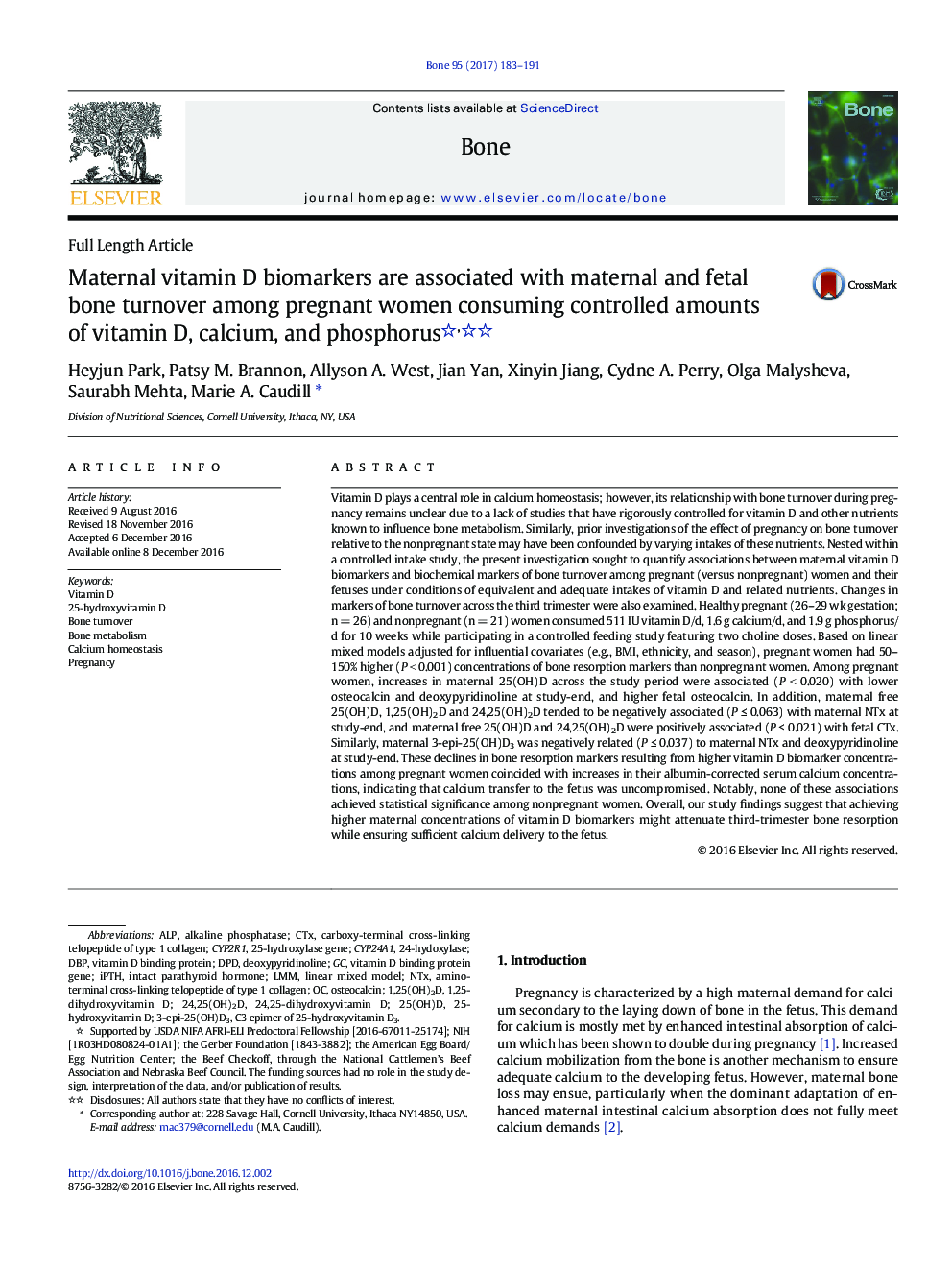| Article ID | Journal | Published Year | Pages | File Type |
|---|---|---|---|---|
| 5585356 | Bone | 2017 | 9 Pages |
Abstract
Vitamin D plays a central role in calcium homeostasis; however, its relationship with bone turnover during pregnancy remains unclear due to a lack of studies that have rigorously controlled for vitamin D and other nutrients known to influence bone metabolism. Similarly, prior investigations of the effect of pregnancy on bone turnover relative to the nonpregnant state may have been confounded by varying intakes of these nutrients. Nested within a controlled intake study, the present investigation sought to quantify associations between maternal vitamin D biomarkers and biochemical markers of bone turnover among pregnant (versus nonpregnant) women and their fetuses under conditions of equivalent and adequate intakes of vitamin D and related nutrients. Changes in markers of bone turnover across the third trimester were also examined. Healthy pregnant (26-29 wk gestation; n = 26) and nonpregnant (n = 21) women consumed 511 IU vitamin D/d, 1.6 g calcium/d, and 1.9 g phosphorus/d for 10 weeks while participating in a controlled feeding study featuring two choline doses. Based on linear mixed models adjusted for influential covariates (e.g., BMI, ethnicity, and season), pregnant women had 50-150% higher (P < 0.001) concentrations of bone resorption markers than nonpregnant women. Among pregnant women, increases in maternal 25(OH)D across the study period were associated (P < 0.020) with lower osteocalcin and deoxypyridinoline at study-end, and higher fetal osteocalcin. In addition, maternal free 25(OH)D, 1,25(OH)2D and 24,25(OH)2D tended to be negatively associated (P â¤Â 0.063) with maternal NTx at study-end, and maternal free 25(OH)D and 24,25(OH)2D were positively associated (P â¤Â 0.021) with fetal CTx. Similarly, maternal 3-epi-25(OH)D3 was negatively related (P â¤Â 0.037) to maternal NTx and deoxypyridinoline at study-end. These declines in bone resorption markers resulting from higher vitamin D biomarker concentrations among pregnant women coincided with increases in their albumin-corrected serum calcium concentrations, indicating that calcium transfer to the fetus was uncompromised. Notably, none of these associations achieved statistical significance among nonpregnant women. Overall, our study findings suggest that achieving higher maternal concentrations of vitamin D biomarkers might attenuate third-trimester bone resorption while ensuring sufficient calcium delivery to the fetus.
Keywords
3-epi-25(OH)D3CYP2R1deoxypyridinoline24,25(OH)2DDPDCYP24A1NTXCTXLMMiPTHDBP1,25(OH)2D1,25-dihydroxyvitamin D24,25-dihydroxyvitamin D25(OH)D25-hydroxyvitamin DALPAlkaline phosphataseOsteocalcinPregnancyBone metabolismLinear mixed modelIntact parathyroid hormoneCalcium homeostasisVitamin DVitamin D binding proteinBone turnover
Related Topics
Life Sciences
Biochemistry, Genetics and Molecular Biology
Developmental Biology
Authors
Heyjun Park, Patsy M. Brannon, Allyson A. West, Jian Yan, Xinyin Jiang, Cydne A. Perry, Olga Malysheva, Saurabh Mehta, Marie A. Caudill,
